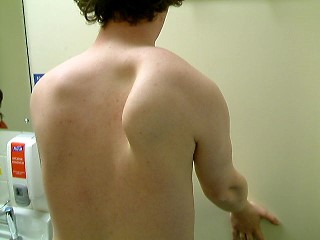Scapular Stability: Part II
In yesterday’s post, we discussed the concepts of scapular stability, and how something like winging of the scapula could be considered akin to building a house on a shaky foundation. In other words, shit done fallen over.
So today we’re going to look at how to continue to develop scapular stability beyond the basic movements shown in Part One. If you haven’t read it yet, you would be wise to do so, because otherwise I’m going to start throwing around words and terms you won’t recognize, and you’ll feel like the odd man out of the inside joke where everyone’s laughing except you, and you think they’re laughing at you, so you go and make a list of names and buy a sniper rifle……. I don’t want that kind of stress, so just check out the other days post, will ya?? So click HERE to read it.
So now that you have some degree of stability in the shoulder from doing the exercises from Day One, it’s time to crank up the volume. Day One was designed to increase awareness of the muscles working, and to try to get a basic level of activation into them without overloading them. A concept to be aware of is too much resistance will pretty much always lead to some form of compensation from the upper traps, lats, or serratus anterior to tilt the scapula into a better position to create movement or stability without having to rely on the weaker muscles like the lower traps, serratus posterior, or rhomboids. That being said, let’s get to the exercises!!
Short lever front arm raise
What it does: Works on the ability to create movement through the saggital plane without overloading the scapula with a long lever arm. The goal is to work on having the scapula return to the same starting position, sitting flush with the ribs on each rep.
Coaching keys: Make sure the spine is in as close to neutral as possible, with no hunching as that will stress the serratus posterior too much and make it hard to keep the scapula gliding properly through the movement.
Side Lying Pull & External Rotation:
What it does: This movement lets gravity act in the frontal plane so that the loads on the scapular stabilizers is reduced while the arm is fully extended overhead. The load is primarily borne by the upper traps and rhomboids, but when you throw in the external rotation, lower trap comes to the party and brings his good buddy serratus posterior, especially if the T-spine is in some extension and the scap is retracted. Those two crazy cats know how to throw DOWN!!!
Coaching cues: try to pull the shoulder blade into your back pocket, and pivot your elbow on your hip to go through external rotation. Reach as high as you can overhead, and pull that sumbitch down all the way. Extra Brownie points if you can still maintain some form of stable scap position with a 3 pound dumbbell in order to make you look completely bad-ass.
Cable Wide arm altered Pollof Press
What it does: This sucker is a beast for anyone with weakness in T-spine extension, scapular retraction or external rotation endurance, and it looks pretty easy but throw 10 pounds on it and work through 15 reps in order to find out what the literal translation of “shit a kidney” would look like.
Coaching Cues: Imagine standing between to panes of glass, and sliding your arms in between them. No butt back, no hips forward, arms staying perfectly parallel with the body, and struggle as much as you can. Sort of like “Deliverance,” but without the creepy banjos.
DB Scap Shrug Row
What it does: Sure, this is a staple in a lot of programs, but to be honest, almost everyone does it wrong!!! I swear I’m going to have to hold my face on a hot stove burner if I keep seeing people shrug their shoulder into the base of their skull while pulling their hand to their shoulder, and flaring their elbow out like they’re trying to deliver a forearm shiver on the offensive line. If done right, there should be almost no pressure in the neck or upper traps, and relies on the lats, lower traps, rhomboids, and biceps to pull the weight in line with the 9th rib (ladies, it’s around the bra strap line. Guys, if you have some extra-curricular activities on the weekend where you know where your bra strap line is, I’m not going to judge). The scapula should move down and in, or in technical terms, it should depress and retract.
Coaching cues: Keep a slight spinal extension, point your tailbone straight back, and pull your shoulder-blade into your opposite pocket, making sure the weight moves up to your ribs and you keep your elbow tight to your side. If done right, you should feel your obliques on both sides tighten up to act as anti-rotation muscles to the unbalanced load, an added bonus to getting beach-ready, or as we in Edmonton prefer to call it, “Mosquito-bait.” Why do I live here again??
DB Bent over Thumbs Up Side Raise
What it Does: The combination of a slightly extended T-spine, scapular positioning, and a healthy dose of external rotation makes this a favorite of mine, and one I try to work on after performing a strength exercise like the row because it demands a lot of motion with strength. It’s sort of like shooting free throws when you’re tired: You have to teach the shoulder how to stabilize even when the major muscles are fatigued. This way the stabilizers have to pull up the slack.
How to Coach it: Similar position as with the row, keep the elbow straight and make the scapula move in the same direction. While moving the arm through the arc, turn the hand so the thumb is pointing behind you and moves in a spiral pattern rather than raise, turn, turn, lower. Less robotic makes you look like you know what you’re doing, and will make women everywhere want to wipe your bench, if you know what I mean!! Wink Wink!!
 So one of the more important points to consider when working with an unstable scapula is that the movements themselves are meaningless. What matters the most is not what movements are done but HOW they are done. Technique is crucial, as the muscles will continue to move into a compensation pattern if overworked. If there is any slight deviation outside of ideal position, the exercise must be stopped, regardless of whether it’s rep number 10 or 2. Having a keen eye and attention to detail becomes really important, so use mirrors if working on your own, and work with a qualified coach who can tell you if you’re in the right position or not. Technique, technique, technique.
So one of the more important points to consider when working with an unstable scapula is that the movements themselves are meaningless. What matters the most is not what movements are done but HOW they are done. Technique is crucial, as the muscles will continue to move into a compensation pattern if overworked. If there is any slight deviation outside of ideal position, the exercise must be stopped, regardless of whether it’s rep number 10 or 2. Having a keen eye and attention to detail becomes really important, so use mirrors if working on your own, and work with a qualified coach who can tell you if you’re in the right position or not. Technique, technique, technique.
Once the shoulder starts to get more stable, you can start to build a strong and powerful “house” on top of it in the form of strength through pressing, pulling, throwing, and other necessary movements of the upper body.
These little tidbits are all well and good, but to hear some more in-depth components from some of the best minds in the business, check out Muscle Imbalances Revealed to hear specifics on knees, hips, back, fascia (mine, hell yeah!!) and running mechanics. Click HERE to check it out and pick up a copy for yourself.
PS. Carl, I check out serratus posterior inferior by graded muscle contraction palpated between the extensor longisimus thoracis and the latissimus dorsi during thoracic extension and rotation concomitant protraction and inhalation. In this case, contraction was felt, but was dominated by other muscles, and couldn’t be isolated, which led me to believe the contraction strength was weak. After giving him the series of exercises, graded contraction was stronger and could actually be isolated. Cool? I’d be open to hearing other ways of testing if you have them, especially if there’s a way to get at that little bugger without picking up intercostals or extensors. I’ve had good luck with this, but it’s definitely not perfect.



8 Responses to Scapular Stability: Part II